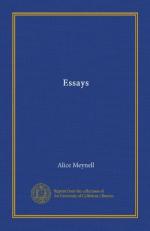The man so possessed suffers the lot of the weakling—subjection to the smallest of the things he has abused. The designer of cheap patterns is no more inevitably ridden by the flower than is the vain and transitory author by the phrase. In literature as in all else man merits his subjection to trivialities by his economical greed. A condition for using justly and gaily any decoration would seem to be a measure of reluctance. Ornament—strange as the doctrine sounds in a world decivilized—was in the beginning intended to be something jocund; and jocundity was never to be achieved but by postponement, deference, and modesty. Nor can the prodigality of the meadows in May be quoted in dispute. For Nature has something even more severe than modertion: she has an innumerable singleness. Her buttercup meadows are not prodigal; they show multitude, but not multiplicity, and multiplicity is exactly the disgrace of decoration. Who has ever multiplied or repeated his delights? or who has ever gained the granting of the most foolish of his wishes—the prayer for reiteration? It is a curious slight to generous Fate that man should, like a child, ask for one thing many times. Her answer every time is a resembling but new and single gift; until the day when she shall make the one tremendous difference among her gifts—and make it perhaps in secret—by naming one of them the ultimate. What, for novelty, what, for singleness, what, for separateness, can equal the last? Of many thousand kisses the poor last—but even the kisses of your mouth are all numbered.
UNSTABLE EQUILIBRIUM
It is principally for the sake of the leg that a change in the dress of man is so much to be desired. The leg, completing as it does the form of man, should make a great part of that human scenery which is at least as important as the scenery of geological structure, or the scenery of architecture, or the scenery of vegetation, but which the lovers of mountains and the preservers of ancient buildings have consented to ignore. The leg is the best part of the figure, inasmuch as it has the finest lines and therewith those slender, diminishing forms which, coming at the base of the human structure, show it to be a thing of life by its unstable equilibrium. A lifeless structure is in stable equilibrium; the body, springing, poised, upon its fine ankles and narrow feet, never stands without implying and expressing life. It is the leg that first suggested the phantasy of flight. We imagine wings to the figure that is erect upon the vital and tense legs of man; and the herald Mercury, because of his station, looks new-lighted. All this is true of the best leg, and the best leg is the man’s. That of the young child, in which the Italian schools of painting delighted, has neither movement nor supporting strength. In the case of the woman’s figure it is the foot, with its extreme proportional smallness, that




